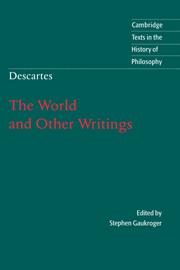Book contents
- Frontmatter
- Contents
- Acknowledgements
- Introduction
- Chronology
- Further reading
- Note on the texts
- The World and Other Writings
- The Treatise on Light
- Discourse 2 of the Dioptrics
- Discourse 8 of the Meteors
- The Treatise on Man
- Description of the Human Body
- Index
- Cambridge texts in the history of philosophy
Description of the Human Body
Published online by Cambridge University Press: 17 December 2009
- Frontmatter
- Contents
- Acknowledgements
- Introduction
- Chronology
- Further reading
- Note on the texts
- The World and Other Writings
- The Treatise on Light
- Discourse 2 of the Dioptrics
- Discourse 8 of the Meteors
- The Treatise on Man
- Description of the Human Body
- Index
- Cambridge texts in the history of philosophy
Summary
There is no more fruitful occupation than to try to know oneself. And the benefit that one expects from this knowledge does not just extend to morals, as many may initially suppose, but also to medicine in particular. I believe one can find very many reliable precepts in medicine, as much for curing illness as for preventing it, and even also to slow the course of ageing, so long as one has studied sufficiently to know the nature of our body, not attributing to the soul functions which depend only on the body and on the disposition of its organs.
But because it is the experience of everyone from childhood that many of our movements obey the will, which is one of the powers of the soul, this has disposed us to believe that the soul is the principle behind all of them. And the ignorance of anatomy and mechanics has contributed to this, for in considering only the exterior of the human body, we never imagined that it had enough organs or springs in it to move itself in all the different ways in which we see it move. And we have been confirmed in this error in judging that dead bodies have the same organs as living ones, for they lack nothing but the soul and yet there is no movement in them.
When we make the attempt to understand our nature more distinctly, however, we can see that our soul, in so far as it is a substance distinct from body, is known to us solely from the fact that it thinks, that is to say, understands, wills, imagines, remembers, and senses, because all these functions are are kinds of thoughts.
- Type
- Chapter
- Information
- Descartes: The World and Other Writings , pp. 170 - 205Publisher: Cambridge University PressPrint publication year: 1998
- 1
- Cited by



